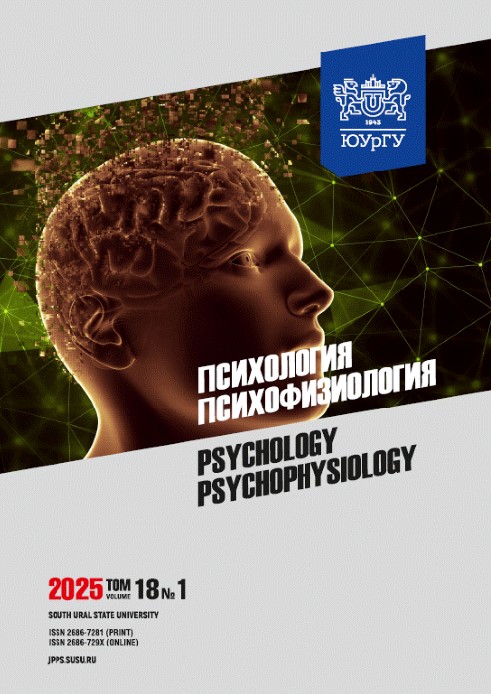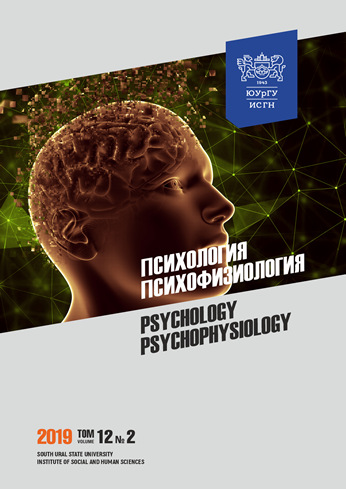Deviant behavior in virtual space: cyberbullying and cyberloafing
Abstract
Introduction. Internet technologies have become integral to modern life, giving rise to novel forms of deviant behavior in virtual space, such as cyberloafing and cyberbullying. Therefore, the relationships between these phenomena require further investigation. Aims: to identify the relationship between cyberloafing and cyberbullying among school and university students. Materials and methods: a survey of 344 students aged 14–22 was conducted (128 schoolchildren, 216 university students; Chelyabinsk) using Y. Akbulut’s cyberloafing scale and A.A. Rean’s cyberbullying scale. Data were analyzed using the Mann–Whitney U test, CHAID analysis, and chi-squared test (IBM SPSS Statistics v 27.0). Results. The study revealed that while students rarely engage in phone use during classes, they frequently utilize communication and information-seeking functions on social media. Most respondents were not involved in cyberbullying, but approximately one-quarter had experienced it in the past month. Gender differences emerged, with girls less likely to engage in cyberbullying than boys. Being a witness or a victim of cyberbullying was associated with a frequency of phone communication during classes, while being an aggressor was linked to phone communication and gaming cyberloafing during classes. Conclusion. This research demonstrates the relationship between gaming/communicative cyberloafing and cyberbullying. The findings contribute to a better understanding of deviant behavior in virtual space and highlight the need for further investigation into these phenomena
Downloads
References
2. Sivrikova N.V., Yaroslavova G.Yu., Kharlanova E.M., Dyadyk N.G. Deviantnoe povedenie v sovremennom mire: v fokuse vnimaniya bulling [Deviant behavior in the modern world: the focus is on bullying]. Chelyabinsk: YuURGPU Publ. 2023:177. (in Russ.).
3. Novikova M.A., Rean A.A., Konovalov I.A. Bullying in Russian schools: experience in diagnosing prevalence, gender and age characteristics and connections with school climate. Voprosi obrazovaniya = Education issues. 2021;3:62–90. (in Russ.).
4. Sivrikova N.V., Ptashko T.G. Deviant behavior in the modern world: focus on media consumption. Chelyabinsk: YuURGPU Publ. 2024:204. (in Russ.).
5. Reizer A., Galperin B.L., Chavan M. et al. Examining the relationship between fear of COVID-19, intolerance for uncertainty, and cyberloafing: A mediational model. Journal of Business Research. 2022;145:660–670. DOI: 10.1016/j.jbusres.2022.03.037.
6. Escario J.-J., Giménez-Nadal J.I., Wilkinson A.V. Predictors of adolescent truancy: The importance of cyberbullying, peer behavior, and parenting style. Children and Youth Services Review. 2022;143:106692. DOI: 10.1016/j.childyouth.2022.106692.
7. Вussu A., Pulina M., Ashton S.-A., Mangiarulo M. Exploring the impact of cyberbullying and cyberstalking on victims behavioural changes in higher education during COVID-19. International Journal of Law, Crime and Justice. 2023;75:100628. DOI: 10.1016/j.ijlcj.2023. 100628.
8. Putintseva A.V. Development of the phenomenon of cyberbullying: analysis of approaches to definition. Vestnik Ufimskogo yuridicheskogo instituta MVD Rossii = Bulletin of the Ufa Law Institute of the Ministry of Internal Affairs of Russia. 2020;3(89):51–57. (in Russ.).
9. Bashmakova E.A., Degtyarev E.A. Factors and social causes of bullying and cyberbullying in adolescence. Problemi sovremennogo pedagogicheskogo obrazovaniya = Problems of modern teacher education. 2021;71(1):36–38. (in Russ.).
10. Prikhodko A.A., Suvorova I.Yu. School bullying: systematicity and counteraction. Sovremennaya zarubejnaya psihologiya = Modern foreign psychology. 2022;11(4):136–144. DOI: 10.17759/jmfp.2022110412. (in Russ.).
11. Margaretha M., Sherlywati M.Y., Mariana A. et al. Cyberslacking behavior and its relationship with academic performance: a study of students in Indonesia. European Journal of Educational Research. 2021;10(4):1881–1892. DOI: 10.12973/eu-jer.10.4.1881.
12. Soldatova G.U., Chigarkova S.V., Kalinina K.R. Psychological characteristics of participants in a cyberbullying situation: analysis of online role behavior. Poznanie i perejivanie = Cognition and experience. 2022;3(1):46–71. (in Russ.).
13. Andel S.A., Kessler S.R., Pindek S. et al. Is cyberloafing more complex than we originally thought? Cyberloafing as a coping response to workplace aggression exposure. Computers in Human Behavior. 2019;101:124–130.
14. Saleh М., Daqqa I., Abdul Rahim M.B., Sakallah N. The effect of cyberloafing on employee productivity. International Journal of advanced and applied sciences. 2018;5(4):87–92.
15. Tsai Hung-Yu Do you feel like being proactive day? How Daily Cyberloafing Influences Creativity and Proactive Behavior: The Moderating Roles of Work Environment. Computers in Human Behavior. 2023;138:107470. DOI: 10.1016/j.chb.2022.107470.
16. Shabden M., Bulatbaeva A., Doshybekov A. et al. Impact of university E-Learning environment on value orientations of students. World Journal on Educational Technology. 2022;14(2):473-483. DOI: https://doi.org/10.18844/wjet.v14i2. 6975.
17. Alibayeva Z., Sarsenbayeva B., Temirgalieva S. et al. Socio-cultural development of students in the context of dialogue technology. World Journal on Educational Technology. 2022;14(3):951–962. DOI: 10.18844/wjet.v14i3.7320.
18. Jiang J., Cameron A-F., Opoku-Mensah E .Toward a multilevel framework of multicommunicating: Insights from a systematic review. Computers in Human Behavior Reports. 2023;12(3):100349. DOI: 10.1016/j.chbr. 2023.100349.
19. Ritzhaupt A.D., Huang R., Sommer M. et al. A meta-analysis of the impact of gamification in formal educational settings on affective and behavioral outcomes. Educational Technology Research and Development. 2021;69:2493–2522. DOI: 10.1007/s11423-021-10036-1
20. Flynn R.M., Kleinknecht E., Ricker A.A., Blumberg F.C. A narrative review of methods used to examine digital gaming impacts on learning and cognition during middle childhood. International Journal of Child Compute Interaction. 2021;30:100325. DOI: 10.1016/j.ijcci.2021.100325
21. Macaulay P.J.R., Betts L.R., Stiller J., Kellezi B. Bystander responses to cyberbullying: The role of perceived severity, publicity, anonymity, type of cyberbullying, and victim response. Computers in Human Behavior. 2022:131.е-107238. DOI: 10.1016/j.chb.2022.107238
22. Мei T.K., Mahamood A.F., Abdullah S., Yakob T.K.T., Mokhdzar Z.A. Cyberloafing Behavior and Its Effects Towards Academic AchievementAmong Students in Higher Education Institution. Journal of Human Development and Communication. 2021;10:115–133. Available at: http://dspace.unimap.edu.my:80/xmlui/handle/123456789/74720 (accessed: 25.04.2024)
23. Juuti K., Kervinen A., Loukomies A. Quality over frequencyinusing digital technology: Measuring the experienced functionaluse. Computers and Education. 2022;176:104361. DOI: 10.1016/j.compedu.2021.104361.
24. Huang E., Xing Y., Song X. Emotional Analysis of Multiplayer Online Battle Arena (MOBA) Games Addiction. Frontiers in Psychology. 2024;15:1347949 DOI: 10.3389/fpsyg.2024.1347949.
25. Zhang H., Chen C., Zhang L. et al. The association between the deviation from balanced time perspective on adolescent pandemic mobile phone addiction: the moderating role of self-control and the mediating role of psychological distress. Frontiers in Psychology. 2024;14:1298256. DOI: 10.3389/fpsyg.2023.1298256.
26. Kurmanova А., Kozhayeva S., Ayupova G. et al. University students relationship with technology: Psychological effects on students. World Journal on Educational Technology. 2023;15(1):1225–1233. DOI: 10.18844/wjet.v14i4.7743
27. Kim J.H., Song H.Y. and Jung G.H. Relationship between positive parenting and cyberbullying perpetration among adolescents: role of self-esteem and smartphone addiction. Frontiers in Psychology. 2024;14:1252424. DOI: 10.3389/fpsyg. 2023.1252424.
28. Martínez-Monteagudo А., Martínez-Monteagudo М., Delgado В. School bullying and cyberbullying in academically gifted students: A systematic review. Aggression and Violent Behavior. 2023;71:101842. DOI: 10.1016/j.avb.2023.101842.
29. Pepler D., Mishna F., Doucet J., Lameiro M. Witnesses in cyberbullying: Roles and dilemmas. Children and Schools. 2021;43(1):45–53. DOI: 10.1093/cs/cdaa027
30. Nawaz S. Rethinking classifications and metrics for problematic smartphone use and dependence: Addressing the call for reassessment. Computers in Human Behavior Reports. 2023;12(4):100327. DOI: 10.1016/j.chbr.2023.100327.
31. Jabeen F., Tandon A., Azad N. et al. The dark side of social media platforms: A situation-organism-behaviour-consequence approach. Technological Forecasting and Social Change. 2023;186(A):122104. DOI: 10.1016/j.techfore.2022.122104
References on translit
-Copyright (c) 2025 Psychology. Psychophysiology

This work is licensed under a Creative Commons Attribution-NonCommercial-NoDerivatives 4.0 International License.



